Northeast Regional
Topic 16142 | Page 2
Welcome to Maine. The Walmart dc is real easy to get to. The unfortunate part is that it's in the dirty lew. Lock your truck when you get out. Its well known up here to be the arm pit of Maine. There's tons of places you can park overnight if needed. Try not to stay in that town if you can avoid it. There's a large truck stop off exit 80 in auburn which is not bad. There's others too if you're heading south. I'll give you some hints if you ever need them. Good luck

Welcome to Maine. The Walmart dc is real easy to get to. The unfortunate part is that it's in the dirty lew. Lock your truck when you get out. Its well known up here to be the arm pit of Maine. There's tons of places you can park overnight if needed. Try not to stay in that town if you can avoid it. There's a large truck stop off exit 80 in auburn which is not bad. There's others too if you're heading south. I'll give you some hints if you ever need them. Good luck
Since she is running Walmart store loads, usually dedicated drivers can park inside the DC compound, use the facilities there, etc.
Most Walmart DC have cafeterias that run from 6am to 10pm, vendateria after hours. I have full access to the one at my DC.

I spent a week "temping" as a WM Frozen Dairy Deli delivery. Just like G-town is filling you in on. But I'm adding in my one goof:
You do check the pallets as they are unloaded by store staff. DO NOT LET ANY GET BY YOU without your checking. One store took off one too many. I got to my next store, they asked, "Where's pallet #6?" I ended up calling the previous store, yes, it was there. Guess who had to drive back to that store and return with the missing pallet? And who lost 1-1/2 hours of drive time?
So true. This occurred to me seversl times the first few months. Really need to keep track of things, the bigger stores will have team unloading you, must make sure they only put away the pallets designated for them.
I hope they put you on a dry van run your first few times, they are far easier to supervise. I'll send you more info shortly.
Dry Van:
A trailer or truck that that requires no special attention, such as refrigeration, that hauls regular palletted, boxed, or floor-loaded freight. The most common type of trailer in trucking.
Part two… Quick note about backing,…you will be doing a lot of it, at times in close quarters. Your LW will really benefit you on this account. You are at least a foot shorter than most condo-sleepers, and a deeper setback front axle. Until you get the hang of this, do your GOAL before you start your set-up. Most stores will have enough room where you can park and check out the dock. Look where there are obstructions; other trailers, pallet stacks, containers, light standards, fences, walls, standpipes and the infamous yellow pole deer. Some of the docks will have yellow lines painted on the ramp, others won’t. Some of the older dock doors are narrower, for those you almost need to place your trailer exactly centered. They are all different. So,…survey the dock area before performing your setup and back. Take your time and don’t hit anything,…cameras are everywhere. Remember, your clock is always running, getting docked, into the store, unloaded and moving again shouldn’t take more than 1 hour. My goal is 45 minutes maximum for a delivery stop. My average is 35. Gotta really hustle.
This an image of the dock at a store located in Reading PA. Typical of a newer store dock. For my setup at this store I nose into the ramp area as deep as I can go without hitting anything and pull hard right to come back out and straighten out. This will put me in the best position for a 45 degree angle back to the dock.
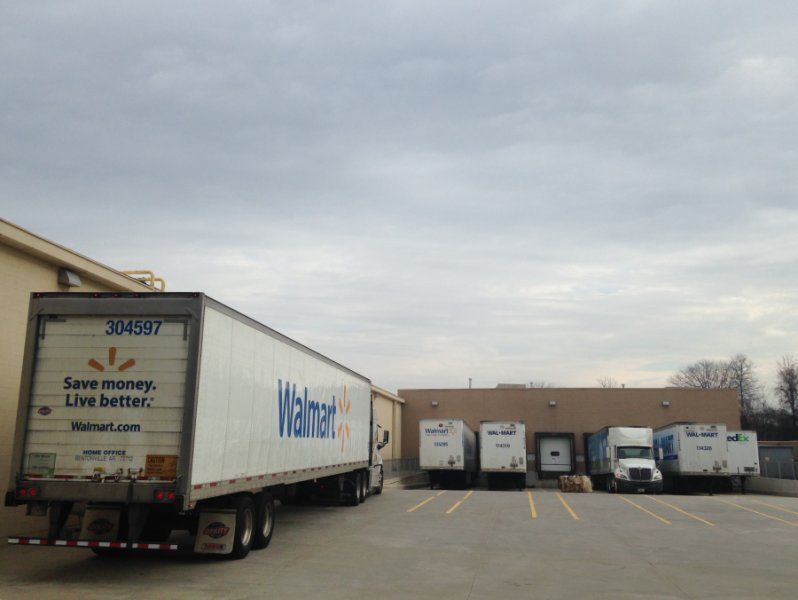
When you get to the store and once in, the unloading will usually begin when they have the dock bridge in place. Most of them are air actuated, although there are still the old pull-chain style around. They will ask what you have; if reefer tell them how many of each category you are delivering. For example; 3 dairy, 2 frozen, 2 dairy need to be moved to get to the frozen. If you are running dry, tell them you have X number of REMIX pallets. As they unload, you need to pull inventory ticket stickers from the inventory tag on the pallet, and attach them to the back of the load map sheet. There is a minimum of one ticket per pallet, I have seen as many as three for a single pallet. Sometimes they are easy to find, sometimes you’ll need to look for them. Ask the unloader to help you. I usually pull stickers in the trailer so there is no delay in getting them off. Make sure the inventory tag store number on the pallet matches the store you are currently delivering to. I suggest getting a small flash light to help with “seeing” the inventory tickets. Home depot sells a small flash light with a belt holster. It has a spot-light feature with a pencil beam. Very bright.
So for a dry “REMIX” load, everything is usually loaded sequentially. I have from time-to-time, found a pallet in a spot it wasn’t supposed to be on a dry load, keep track as they come off and make sure the count matches the number on the map. If there is a pallet topped on another one, it counts as one pallet. For a reefer, it’s more complicated. Your first run is three stops, it shouldn’t be too difficult. Loads with 4-6 stops are far more difficult to manage and take apart. Until you get experience doing this, try to request they not give you a five stop run during your first couple of weeks.
If running reefer, before leaving the DC, you will need to make sure your tank is at least ¾ full. Each DC has a fuel island designated for reefer fuel. When you remove the fill-cap, on the fill collar, there is a plastic ring. This ring needs to be pulled up and mated to the fuel pump nozzle. This sends information to a computer system recording the trailer number, reefer hours and other information. This “docking” needs to validate before you can fuel. Should only take a couple of seconds. If it doesn’t work, you will need to get the hours from the reefer unit and enter them manually. Get the Walmart fuel pad attendant to help you if this happens.
The Walmart reefer trailers have 3 temperature zones, separated by movable split-bulkheads. They are on a track and move fairly easy. There is a set of rope-pulleys for each half that are used for lifting and holding them in place to access that zone. There is a clip at the end of each rope that attaches to a hook on each door. The driver is responsible for moving and resetting the bulkheads. Although it’s ok to ask for help, it’s still part of your job to move and lift the bulkheads. The bulkheads have a pair of logistics straps and three Velcro closures to secure and seal the zone. Below, bulkheads in the lowered, sealed position and in the raised position. The "raised" image shows zones 3, 2. Notice all the frost in zone 2. Be careful,...it gets slippery. I have boots with non-skid, slip resistant soles. The air-circulation units are visible on the ceiling, one in zones 3 and a pair for the sub-zero center zone 2. Zone one has a conventional nose mounted air circulation unit.
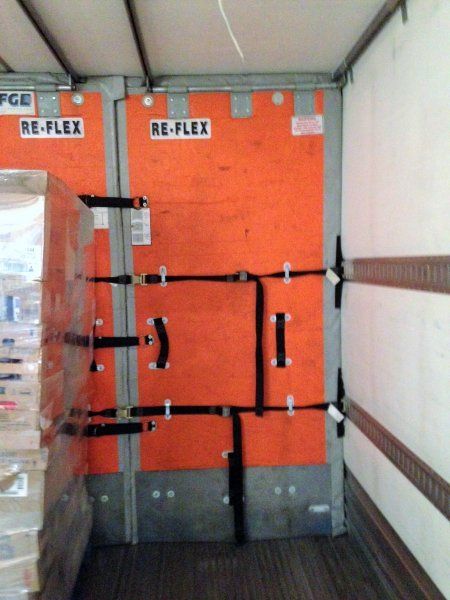
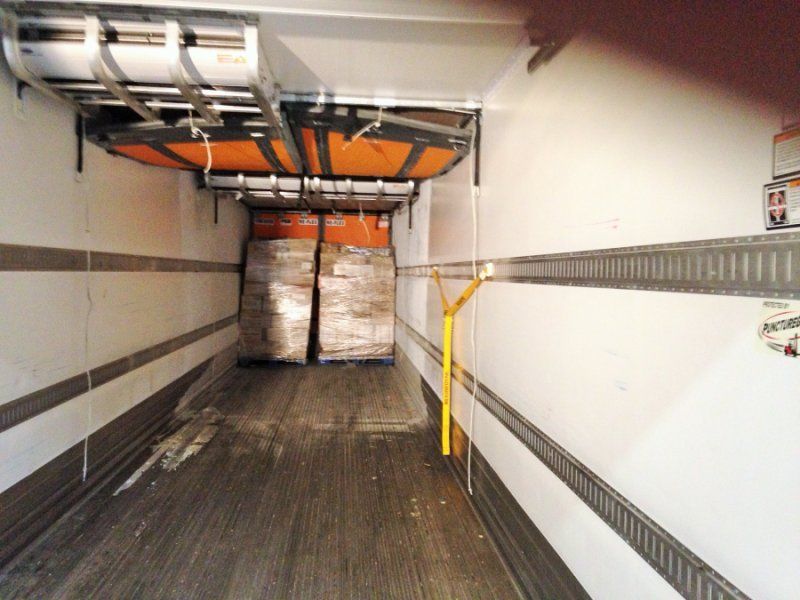
Part 3 coming shortly...
Bulkhead:
A strong wall-like structure placed at the front of a flatbed trailer (or on the rear of the tractor) used to protect the driver against shifting cargo during a front-end collision. May also refer to any separator within a dry or liquid trailer (also called a baffle for liquid trailers) used to partition the load.
Reefer:
A refrigerated trailer.
HOS:
Hours Of Service
HOS refers to the logbook hours of service regulations.
Part 3...
You will also need to turn off the air circulation units in each zone as you enter it, especially the sub-zero, center section. Also use gloves inside the reefer , stuff is really cold and your bare hands could stick to frozen metal. Turn the units on before sealing the trailer. There is a remote control panel recessed in the interior wall, driver’s side near the door opening. No need to use the panel on the main reefer unit outside the trailer. Everything you need to turn the units on/off and reset temps is available on the remote control panel. Left side is self explanatory, right side: the "=" symbol is for the menu. Up and down arrow allows menu navigation. The only time you will need to use the menu function is for changing the temps for a backhaul or in the heat of the summer (90 degrees or greater) they will request 33 degrees for the whole box when returning empty. Otherwise shut down the entire unit.
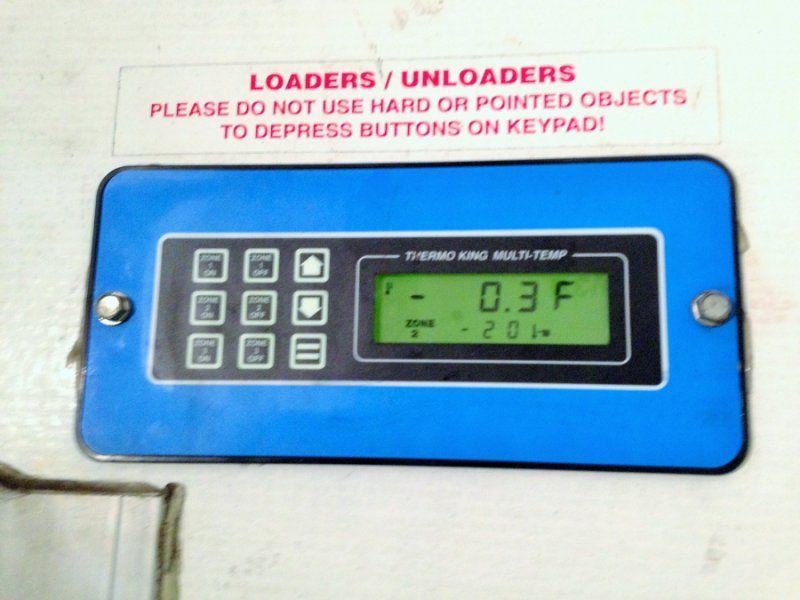
Couple of final notes. Unless you have a backhaul or are moving a pallet return, you must arrive back at the DC empty. The other thing to keep in mind, try to make it back to the DC the same day/shift. In order to maximize your clock, starting the next day with a stopped clock is really important.
At our DC in Gordon, we train any new driver for a minimum of two, sometimes three days. I hope you have a similar process at Prime. If not, ask for help. Ask them to walk you through the paperwork. Also near the driver window, there will be a dry erase board with current information about stores, backhaul vendors, and miscellaneous information pertaining to Walmart. Read it and check if any of the current information is relevant to the stores you are delivering to. Fortunately you have a good head on your shoulders. That will help you quickly learn the delivery process. Making your deliveries in an expedient manner is the challenge. Not an easy gig for a rookie driver. I started running Walmart after 3 months of OTR experience,…really struggled for the first month. At month 6 on the account I was more comfortable and learning how to produce and make a good living. Trust me, once you get the hang of this account, you can make a whole lot of money doing it and never be without a load. Never.
Below image is one of the newer units, 308 series built earlier in the year. The newer trailers 305 series through 309 have no distinctive Walmart marking except for the DC number on the door and on the reefer unit, and the word "Walmart" in a small font below the reefer unit. The older units had billboard markings, but many were de-branded as they were readied for resale.

OTR:
Over The Road
OTR driving normally means you'll be hauling freight to various customers throughout your company's hauling region. It often entails being gone from home for two to three weeks at a time.
Reefer:
A refrigerated trailer.
Welcome to Maine. The Walmart dc is real easy to get to. The unfortunate part is that it's in the dirty lew. Lock your truck when you get out. Its well known up here to be the arm pit of Maine. There's tons of places you can park overnight if needed. Try not to stay in that town if you can avoid it. There's a large truck stop off exit 80 in auburn which is not bad. There's others too if you're heading south. I'll give you some hints if you ever need them. Good luck
I'm delivering there tomorrow (as I do most weeks). Hey, I know about the Irvings at Auburn and Kittery, and of course there's the rest stops, but is there anything else in Maine south of Auburn?
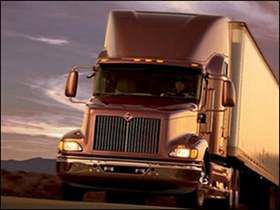
I have done dedicated WM runs out of that dc a couple of times. It is easily the most well organized dc for store runs that I have seen. Nice facility, good folks in the Prime office, and they handle some of the QC macros for you! I will second what has been said about reading trip sheets and looking at satellite views of stores. It will aave a lot of potential heartache. I had to deliver to some WM stores in Maine just before the July 4th holiday and the parking lots were a circus.

Hey! Sorry I'm updating so late. THANK YOU for all the info. It was super helpful! The first couple of runs were a learning experience, but now it's already old hat. Basically I run frozen and dairy, usually overnight, which I love. Hardly any traffic. I run those with an average of 4 stops a night. My biggest issue is getting the store to open the door to let me in. Buzzer doesn't summon anyone. They don't answer the phone for me or the FM. If the store is open I go in and start asking for a manager. If they're not, I go to the main doors and just start banging and waving my papers. The worst at this is Leominster.
After running about 4 days of this, I will get a meat load that picks up in Easton and delivers to Hatfield, PA, then a return load from here back to Lewiston to do it all again.
I FREAKING LOVE THIS. I don't understand all the hate for driving in New England. What traffic??? Even in the day time and rush hour it's NOTHING like the Washington DC AREA where I'm from.
Question about Lewiston. I drove around and it seemed ok. If I get to stay on this route permanently I'm looking to move to the area. Is it really that bad? I'm used to city living, which has it's good and bad areas, sometimes right next to each other. Tell me about the area.
Fm:
Dispatcher, Fleet Manager, Driver Manager
The primary person a driver communicates with at his/her company. A dispatcher can play many roles, depending on the company's structure. Dispatchers may assign freight, file requests for home time, relay messages between the driver and management, inform customer service of any delays, change appointment times, and report information to the load planners.HOS:
Hours Of Service
HOS refers to the logbook hours of service regulations.
Oh, I will add that the best thing about this experience has not only been the breathtaking scenery I'm surrounded by, but the constant backing practice. I swear on any book you give me that I went from terrified of backing to not being afraid of it whatsoever in a mere 5 days. I'm still not awesome at it, but I'm no longer afraid of it.
Other things I've learned up here:
*red hot dogs are a thing
*too many syllables is bad (Worcester is Wooster and Leominster is Limmister, etc.)
*ayuh bob is a positive response to everyone whether or not your name is actually Bob
*there are no other ethnicities up here other than caucasian it seems
And where are the moose??? There are signs everywhere for them but so far I haven't seen one. I've seen beavers, foxes, huge birds of prey, and deer. But no moose. 
OOS:
When a violation by either a driver or company is confirmed, an out-of-service order removes either the driver or the vehicle from the roadway until the violation is corrected.
New Reply:
New! Check out our help videos for a better understanding of our forum features

















Preview:
This topic has the following tags:
Swift Transport Advice For New Truck Drivers Dealing With The Boss Dedicated Jobs First Solo Months On The Road Regional Jobs Safe Driving Tips Tips For Backing Truck Equipment







 TT On Facebook
TT On Facebook
I spent a week "temping" as a WM Frozen Dairy Deli delivery. Just like G-town is filling you in on. But I'm adding in my one goof:
You do check the pallets as they are unloaded by store staff. DO NOT LET ANY GET BY YOU without your checking. One store took off one too many. I got to my next store, they asked, "Where's pallet #6?" I ended up calling the previous store, yes, it was there. Guess who had to drive back to that store and return with the missing pallet? And who lost 1-1/2 hours of drive time?